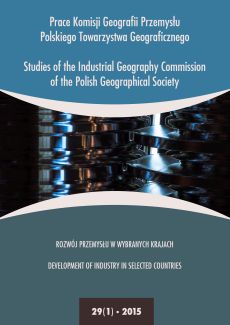Large scale industrial enterprises in Turkish industry: their structures, characteristics and spatial distribution
DOI:
https://doi.org/10.24917/20801653.291.6Keywords:
industry, industrial enterprises, large scale, spatial distribution, TurkeyAbstract
Industrialization is a process which is based on precise and quantitative measurements andcontains different basic changes in the economic structure of a country or region. The structural characteristicsand spatial distribution of the industrial enterprises established during the industrialization processwhich is one of the most important elements of the socio-economic transformation in Turkey withina historical process has been the object of this study. The aim of the study was to establish the positionsand significance of one thousand (1000) large industrial companies in the industry of Turkey by usingthe framework of criteria based on sales from production which have been maintained by the IstanbulChamber of Industry on a regular basis. The workplace and number of employees of the companies ona province basis, sector based division, realized exports and sales from product output, corporate entities,structures, spatial distribution and other characteristics were taken into consideration in the study.Although the thousand large scale companies in Turkey based on production output sales comprised only0.40% of the enterprises active in the industrial sector in 2012, they comprised 12% of the labor force,59.6% of product output sales and 65.2% of all exports. On a regional basis, 54% of these companiesare located in the Marmara region, 13.2% are located in Central Anatolia and 12.4% are located in theAegean region; on a province basis, 63.4% are located in Istanbul, Izmir, Bursa, Kocaeli and Ankara.A sector based division of the companies shows that 21.4% are involved in food, beverage and tobaccoprocessing, 19.6% are involved in the industry of metal goods, machinery, automotive industry, electricaltools and equipment and 16.1% deal with textiles, ready-to-wear, leather and the manufacturingof shoes. In terms of labor force numbers, the figures vary as 18.9%, 27.4% and 17.9% respectively.Downloads
Metrics
References
Doğan, N.M. (2012).Rakamlarla Özelleştirme: Türkiye’de ve Dünyada Özelleştirme Uygulamaları ve Özelleştirme Fonu’nun Kaynak ve Kullanımları, TC. Özelleştirme İdaresi Başkanlığı, Ankara.
Eldem, V. (1970).Osmanlı İmparatorluğu’nun İktisadi Şartları Hakkında Bir Tetkik, Türk Tarih Kurumu Yay. VII Dizi, S. 96, Ankara.
Işık, Ş. (2000). Türkiye’de Sanayi Faaliyetlerinin Dağılışında Meydana Gelen Değişmeler (1982– 1996), Ege Coğrafya Derg.,11, 111–130.
İstanbul Sanayi Odası (İSO). (2012).Türkiye’nin Birinci 500 Sanayi Kuruluşu Verileri, İstanbul.
İstanbul Sanayi Odası (İSO). (2012).Türkiye’nin İkinci 500 Sanayi Kuruluşu Verileri, İstanbul.
Kara, H. (1990). Çukurova’da Endüstri, AKDTYK Coğrafya Bilim ve Uygulama Kolu Coğrafya Araş. Derg., 1(2), 193–226.
Karakuyu, M. (2008). Hadımköy’ün Sanayileşme Süreci; Gelişme Nedenleri, Yapısı ve Sorunları, Marmara Coğrafya Derg., 18, 21–49.
Kepenek, Y. (1986). Gelişimi, Üretim Yapısı ve Sorunlarıyla Türkiye Ekonomisi,Teori Yay., Ankara.
Mutluer, M. (1995). Gelişimi, Yapısı ve Sorunlarıyla Denizli Sanayi,Denizli Sanayi Odası Yay., İzmir.
Ökçün, G. (1970).Osmanlı Sanayi: 1913–1915 Yılları Sanayi İstatistikleri, Ankara Üniv. Siyasi Bilgiler Fak. Yay., Ankara.
Özerkmen, N. (1994). Türkiye’de Küçük Sanayinin Yapısı ve Bugünkü Durumu, Ankara Üniv.Dil- Tarih Coğrafya Fakültesi Felsefe Bölümü Derg., 15, 275–292.
Siyaset, Ekonomi, Toplum Araştırmaları Vakfı (SETA). (2012). Seta Perspektif Bülteni, Ankara.
Sevgi, C. (1994). Sanayileşme Sürecinde Türkiye ve Sanayi Kuruluşlarının Alansal Dağılımı, Beta Basım-Yayım, İstanbul.
Özgüç, N. (1986–87). Türkiye’de Sanayi Faaliyetlerinin Gelişmesi, Yapısı ve Dağılışı, İstanbul Üniv. Ed. Fak. Coğrafya Derg., 2, 35–70.
Temurçin, K. (2004). Isparta İlinde Sanayinin Gelişimi ve Yapısı, Ankara Üniv. Coğrafi Bilimler Derg., 2(2), 7995.
Temurçin, K. (2013). The development and structure of industry in the disrict of Bağcılar(İstanbul), Bulletin of Geography-Socio Economic Series, 20, 95–111.
Temurçin, K., Aldırmaz, Y. (2013). The development and structure of industry in the district of Ümraniye-İstanbul, Studies of the Industrial Geography Commission of the Polish Geographical Society, 26, 207–223.
Türkiye Ekonomi Politikaları Araştırma Vakfı (TEPAV). (2012). İstihdam İzleme Bülteni, 7, İstanbul.
Türkiye İhracatçılar Meclisi (TİM). (2012). İhracat İstatistikleri, Ankara.
Türkiye İstatistik Kurumu (TÜİK). (2012). Hane Halkı İşgücü Araştırması, Ankara.
Tümertekin, E. (1961). İzmir’de Sanayi Faaliyetlerinin Bünyesi ve Dağılışı, Türk Coğrafya Derg., 21, 45–63.
Tümertekin, E. (1961). İstanbul’da Sanayi Faaliyetlerinin Bünyesi ve Türkiye Sanayindeki Yeri, Sosyoloji Derg., 16, 105–125.
Tümertekin, E., (1967). İstanbul’da Bir Sanayi Bölgesi: Bomonti,İstanbul Üniv. Yay., 1282, İstanbul.
Tümertekin, E. (1970). İstanbul Şehri ve Çevresinde Sanayi: Özellikler ve Dağılış, İstanbul Üniv. Coğrafya Enst. Derg., 17, 33–69.
Tümertekin, E., Özgüç, N. (2013). Ekonomik Coğrafya, Çantay Kitapevi, İstanbul.
http://www.iso.org.tr/projeler/arastirmalar/turkiyenin–500-buyuk-sanayi-kurulusu/18.09.2014.
http://setav.org/tr/turkiyede-ihracat–2012-yili-degerlendirmesi/perspektif/3472.
Downloads
Published
How to Cite
Issue
Section
License
Articles are published under the terms of the Creative Commons License (CC BY-ND 4.0; Attribution– NoDerivs).

